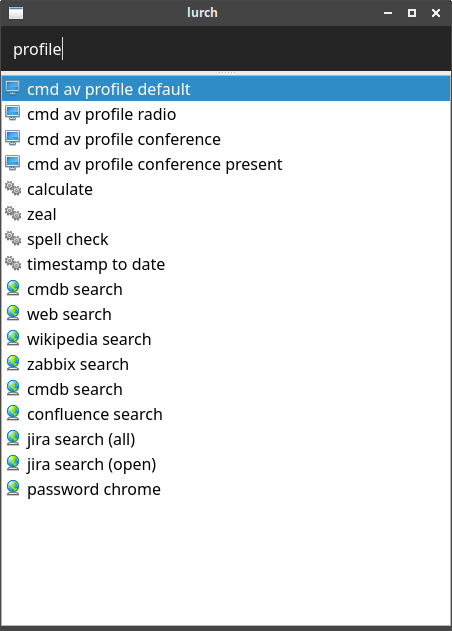An Audio / Video profile switcher (and app launcher) script for Linux
Tuesday, April 13th, 2021
Since the start of Corona, my company has been mostly working remote. That means more video conference meetings. A lot more. So much in fact, that I decided to automate the process of setting everything up correctly for that and other audio video profiles.
For example, my webcam is in my laptop, whose screen I don’t normally use (because virtual desktops == infinite screens right in front of you). Since I’d like people to see me looking at them when we’re conferencing, I want Google Meet to be on the laptop screen. Also, I need to activate my headset.
Switching the internal screen on, switching to the headset, opening Google Meet, dragging it to the laptop’s screen and making the window sticky so it doesn’t disappear when I switch virtual desktops on my main screen… is a bit of a hassle. And since I’m lazy, I decided I need an Audio Video profile switcher.
No such thing existed, so I cobbled together a script, that you can find in a Gist on Github.
The script is reasonably documented I think. It relies heavily on xdotool, wmctrl and pacmd. At the top are some profile definitions for screen layouts, screen coordinates (to move a window to a different screen), and some sound output profiles:
# Use arandr to setup your displays and then export the profile
SCREEN_LAYOUTS[external_only]="
--output HDMI-2 --off
--output DP-1 --off
--output DP-2 --off
--output eDP-1 --off
--output HDMI-1 --primary --mode 1920x1080 --pos 0x0 --rotate normal
"
SCREEN_LAYOUTS[external_left]="
--output HDMI-2 --off
--output DP-1 --off
--output DP-2 --off
--output HDMI-1 --primary --mode 1920x1080 --pos 0x0 --rotate normal
--output eDP-1 --mode 1920x1080 --pos 1920x0 --rotate normal
"
# Screen coordinates for moving windows to a different screen. These are
# coordinates on a virtual desktop that is stretched over all monitors; either
# vertically or horizontally, depending on the screen layout.
SCREEN_COORDS[laptop]="0,1920,0,500,500"
SCREEN_COORDS[external]="0,0,0,500,500"
# This requires a bit of a PhD in pulse audio. There has to be a better way
# Mike!
SOUND_OUTPUTS[headphones]="
pacmd set-card-profile alsa_card.usb-Logitech_Logitech_USB_Headset-00 output:analog-stereo+input:analog-mono;
pacmd set-card-profile 0 output:analog-stereo+input:analog-stereo;
pacmd set-default-sink alsa_output.usb-Logitech_Logitech_USB_Headset-00.analog-stereo;
"
SOUND_OUTPUTS[external_monitor]="
pacmd set-card-profile alsa_card.usb-Logitech_Logitech_USB_Headset-00 off;
pacmd set-card-profile 0 output:hdmi-stereo;
pacmd set-default-sink alsa_output.pci-0000_00_1f.3.hdmi-stereo;
"
Then there’s a bunch of helper functions to do various things such as:
- Change the monitor layout
- Change the audio output profile
- Manipulate windows such as moving them around
Finally, the actual audio video profiles are defined in a big “if, then” statement. I also throw in the launching of some applications just to make things easier. For example, the forementioned “conference” profile:
elif [ "$PROFILE" = "conference" ]; then sound_output "headphones" screen_layout "external_left" firefox --new-window https://meet.google.com/landing?authuser=1 sleep 1 # give firefox a moment win_to_screen "Google Meet" "laptop" win_sticky "Google Meet" win_focus "Google Meet"
I hook all of this up in my Lurch launcher, so that I can just hit Ctrl-alt-semicolon and type the partial name of a profile to switch to it:

I thought I’d share it, since it might be useful for other people. Note that the script may require tweaking to suit your needs, as it’s written for XFCE and other Window Manager might work slightly different.
